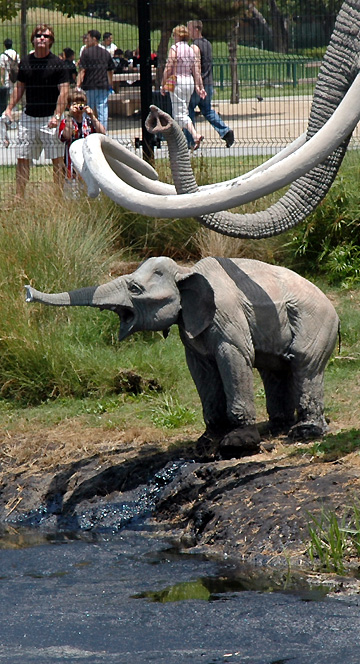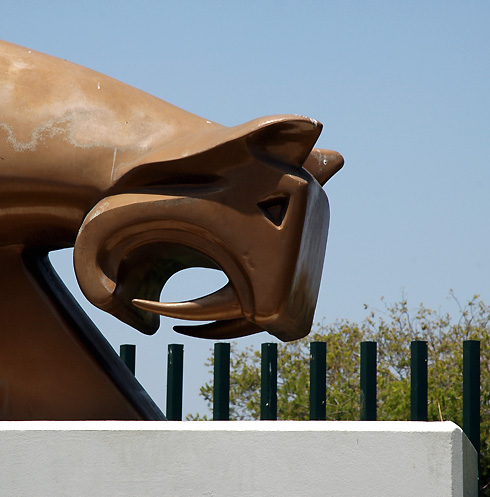Topic: Photos
No Politics Today - The La Brea Tar Pits Instead
One of the more curious sites out here, just down the hill, is not what you expect when you think of Southern California and surfers and movie stars and all that. In the middle of all that we have a place for those into natural history. That would be the La Brea Tar Pits, right down on Wilshire Boulevard. They're famous. Really.
This is how Fodor's describes them -
Well, the place is know for lots of mammal fossils from the last ice age, that glacial age, when Los Angeles was a bit cooler and moister, and there were no freeways and Tom Cruise wasn't in town.About 40,000 years ago, deposits of oil rose to the Earth's surface, collected in shallow pools, and coagulated into sticky asphalt. In the early 20th century, geologists discovered that the sticky goo contained the largest collection of Pleistocene, or Ice Age, fossils ever found at one location: more than 600 species of birds, mammals, plants, reptiles, and insects. More than 100 tons of fossil bones have been removed in excavations over the last seven decades, making this one of the world's most famous fossil sites. You can see most of the pits through chain-link fences. Pit 91 is the site of ongoing excavation; tours are available and you can volunteer to help with the excavations in summer. Statues of a family of mammoths in the big pit near the corner of Wilshire and Curson suggest how many of them were entombed: edging down to a pond of water to drink, animals were caught in the tar and unable to extricate themselves. There are several pits scattered around Hancock Park and the surrounding neighborhood; construction in the area has often had to accommodate them and, in nearby streets and along sidewalks, little bits of tar occasionally and unstoppably ooze up. The Page Museum at the La Brea Tar Pits (PHONE: 323/934-7243) displays fossils from the tar pits. www.tarpits.org ...
The tar pits were described by the early settlers out here in the mid-eighteenth century - "La Brea" is Spanish for "the tar" - and seemed be used as a source of asphalt, used for insulation and this and that. The assumption was the bones they found were from pronghorn deer or local cattle that got stuck in the goop.
What was really there? You've got your mammoths, your dire wolves, your cave bears, your giant ground sloths, and, of course, the State Fossil of California, the saber-toothed tiger - Smilodon Californicus. Does your state have a state fossil? (If you're from North Carolina you can't count Jesse Helms.)
Anyway, the place is cool - even if smells awful (try high-sulfur raw petroleum) as the big black pond still bubbles up methane and tar.
And there is a connection to the movies. Really. In the 1997 movie Volcano from Fox 2000 (a division of Twentieth Century Fox) the black pond is where the magma bursts up and Tommy Lee Jones has to save the city. (Read a review and synopsis here - the budget was seventy million, the screenplay was by Jerome D. Armstrong, the director was Mick Jackson, and it's pretty silly.) The last scene in the movie Miracle Mile (1988) is set here - no volcano in that. Then there is Last Action Hero (1993) where Arnold Schwarzenegger falls into the tar pit pond and easily wipes himself clean, prompting the kid in the film to point out that he (Arnold) is a character in a movie and not in the "real" world. It seems Schwarzenegger is now our governor out here, and he still hasn't figured it out.
But my favorite reference to the La Brea Tar Pits is in The Simpsons' episode "Bart Gets an Elephant" (writer John Swartzwelder, director Jim Reardon, first aired Thursday, March 31, 1994) which goes like this -
The tar pits are kind of a running joke out here.Marge has the family clean the house. Bart listens to the radio and wins his choice of a prize in a radio contest, $10,000 or an elephant. He chooses the elephant. He names the elephant Stampy and falls in love with him. The family neglects the other pets because Stampy demands so much time and money. Homer tries to make money off the elephant, but cannot pay Stampy's food bill. He lets slack-jawed yokels gawk at Stampy. (This is the debut of Cletus.) Homer tries to sell him. Mr. Blackheart, an ivory dealer, gives the best deal. Homer and Marge wake in the middle of the night to find Bart and Stampy missing. Bart runs away with Stampy to save his pet. Homer and the family go to find them at a museum exhibit, and Homer falls into a tar pit. Stampy saves Homer, so Homer decides to give him to an animal refuge. Once there, Stampy reveals himself to be a jerk to the other elephants and Homer reveals himself to be a jerk to the refuge supervisor.
But they are interesting as you can see below (or in the twenty-one shot photo album listed in the left column)-
Goo...

Tragedy

Pathos

A real Saber Tooth in the Page Museum

A stylized Saber Tooth as you enter the grounds...

Posted by Alan at 20:18 PDT
|
Post Comment |
Permalink
Updated: Wednesday, 6 July 2005 11:58 PDT
home


